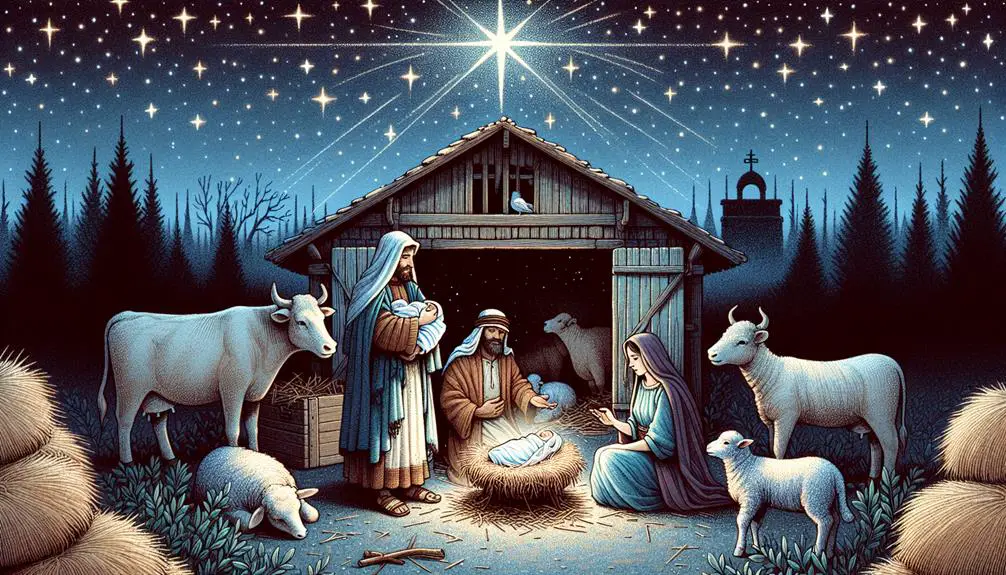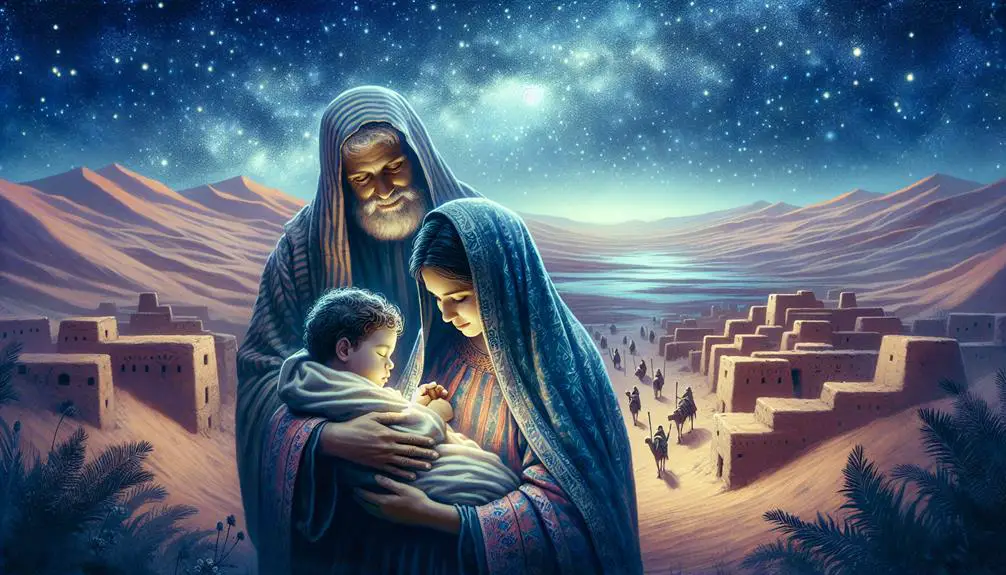Meet the infants who shaped biblical history, from Moses to Jesus, and discover how their early stories foretell a grander narrative of redemption.

Babes in the Bible
Just as a single spark can ignite a vast forest, the stories of infants in the Bible have set aflame the hearts and minds of believers for centuries. You've likely heard of Moses, floating down the Nile, a symbol of hope and survival in the face of despair.
Each babe, from Samuel, called from birth, to Jesus, the prophesied Messiah, plays a pivotal role in the biblical narrative, their stories more than mere footnotes in the annals of faith.
As we explore these ancient texts, you'll find yourself on the cusp of understanding how these early chapters set the stage for the unfolding drama of redemption and faith. What might these stories reveal about divine purpose, human frailty, and the power of innocence?
Key Takeaways
- Infants in the Bible often symbolize divine intervention and beginnings of new eras in salvation history.
- Early divine calls and prophetic dreams in youth demonstrate the significance of young ages in fulfilling God's plans.
- The Nativity scene and stories of miraculous births underscore themes of humility, promise fulfillment, and divine guidance.
- Political instability and cruelty, as seen in Herod's slaughter of infants, highlight the historical and theological complexities surrounding these biblical narratives.
Moses: A Miraculous Survival

Moses' early life encapsulates a tale of miraculous survival, showcasing a divine intervention that marked him as a figure of paramount importance in biblical history. Born into a period of intense persecution, where newborn Hebrew boys were condemned to death by the Egyptian Pharaoh, Moses' existence from the outset was fraught with danger. His mother's decision to hide him for three months, followed by placing him in a basket on the Nile, underscores the desperation and faith that intertwined to preserve his life.
The Nile's protection, often seen as a mere element of geography, transforms into a symbol of divine providence in Moses' narrative. It wasn't just the river's gentle currents that safeguarded the infant but a higher power that guided his path to the daughter of Pharaoh. This basket discovery by Pharaoh's daughter is no mere coincidence but a pivotal moment ordained by fate. It signifies the crossing of paths between a vulnerable Hebrew child and Egyptian royalty, leading to an upbringing that would shape Moses into the leader he was destined to become.
Analyzing this early phase of Moses' life, it's clear that his survival wasn't just a series of fortunate events. It was a meticulously crafted divine intervention that ensured his protection and eventual rise to greatness. The Nile's protection and the basket discovery aren't just elements of a story; they're testaments to the belief that extraordinary circumstances often herald the arrival of extraordinary individuals. Through Moses' survival, we're reminded of the profound impact that divine intervention can have on individual destiny, shaping the course of history in unimaginable ways.
Samuel: Called From Birth
You'll find Samuel's story, marked by his miraculous birth, to be a critical juncture in biblical narratives, emphasizing the sovereignty of divine calls from a young age.
His early life, characterized by a profound divine call and dedication to serving God faithfully, sets a precedent for understanding the dynamics of prophetic ministry in ancient Israel.
Analyzing Samuel's journey offers insights into the interplay between human agency and divine purpose, framing his contributions within the broader context of biblical theology.
Samuel's Miraculous Birth
One cannot overlook the profound significance of Samuel's birth, which not only marked a miraculous event but also predetermined his divine calling from an early age. Hannah's Prayer, a moment of profound despair and hope, became the catalyst for this extraordinary birth. Eli's Reaction, initially one of misunderstanding, eventually turned to a recognition of Hannah's sincere plea for a child.
Aspect |
Detail |
Impact |
|---|---|---|
Hannah's Motivation |
Desire for a child |
Leads to fervent prayer |
Eli's Misinterpretation |
Thinks Hannah is drunk |
Reveals societal judgments |
Divine Intervention |
God hears Hannah |
Samuel's birth promised |
Hannah's Vow |
Dedicates Samuel to God |
Sets Samuel's future path |
Eli's Support |
Blesses Hannah |
Validates her plea |
This narrative showcases the intertwining of human emotion and divine action, setting the stage for Samuel's pivotal role in biblical history.
Divine Call in Youth
Having explored the miraculous circumstances of Samuel's birth, we now turn our attention to his early divine call, a phenomenon that underscores his predestined role in biblical narratives. This call epitomizes youthful resilience, showcasing how even in youth, one can be entrusted with profound spiritual responsibilities.
Samuel's experience with prophetic dreams serves as a cornerstone of this narrative. These dreams weren't mere figments of a vivid imagination but divinely orchestrated messages, marking Samuel's transition from a child under Eli's tutelage to a prophet of unparalleled significance.
This early divine engagement illustrates the critical role of youth in the unfolding of divine plans, suggesting that age isn't a barrier to spiritual significance or to the reception of God's profound revelations.
Serving God Faithfully
From his earliest days, Samuel's life was marked by an unwavering commitment to serving God, a testament to his unique calling from birth. This narrative illustrates a profound example of youthful obedience, a cornerstone for spiritual maturity.
Samuel's early dedication in the temple under Eli's tutelage showcases not just an adherence to religious practice, but a deep-seated devotion that transcends mere duty. This early immersion into spiritual disciplines fostered an environment where Samuel's prophetic gifts could flourish. His responsiveness to God's call, even as a child, underscores the potential for significant spiritual impact, stemming from a foundation of youthful obedience.
Samuel's trajectory from a dedicated youth to a respected prophet exemplifies the transformative power of early, faithful service to God, setting a high benchmark for spiritual maturity.
The Infants of Bethlehem

You'll find the narrative of the infants of Bethlehem deeply embedded in the fabric of biblical stories, marked by Herod's brutal command to slaughter all male children under the age of two.
This act not only showcases the tyrannical fear of losing power but also significantly shapes the early portrayal of Jesus' life, highlighting the dangers He faced from the very beginning.
The impact of this biblical account extends beyond its historical context, inviting readers to reflect on themes of innocence, power, and divine intervention.
Herod's Brutal Command
In an act of unparalleled brutality, King Herod ordered the massacre of all male infants in Bethlehem, aiming to eliminate the prophesied new king. This decree, steeped in historical context, emanated from Herod's fear of losing his throne to the foretold Messiah, highlighting the political instability and ruthlessness prevalent in Judean society under Roman occupation.
The moral implications of this act are profound, evoking questions about the value of innocent lives in the quest for power and the depths of human cruelty. Herod's command, a stark portrayal of absolute despotism, forces you to confront the darker aspects of authority and governance, where the quest for dominance overshadows the sanctity of life, shaping a narrative that resonates through centuries as a chilling reminder of power's potential for corruption.
Biblical Account Impact
Reflecting on Herod's brutal command sheds light on the profound impact the biblical account of the Infants of Bethlehem has had, revealing layers of meaning in religious, cultural, and historical contexts. This narrative has significantly influenced cultural perceptions, embedding itself deeply within the fabric of Christian traditions.
It's served as a poignant symbol of innocence lost, resonating through centuries of art, literature, and music. Regarding historical accuracy, scholars debate the event's factual basis, yet its symbolic value remains undisputed. You must acknowledge how this account has shaped the collective memory of communities, illustrating the power of narrative to transcend literal interpretation.
The Infants of Bethlehem's story underscores the intertwining of faith, culture, and history, demonstrating how biblical narratives continue to inform and enrich human experience.
Jesus: Birth of the Messiah

The birth of Jesus, heralded as the Messiah in Christian theology, marks a pivotal moment in biblical history, embodying divine intervention in human affairs. This event, often depicted in the Nativity scene, carries profound theological implications. It's not merely a tale of a child's birth but a narrative rich with symbolic elements, including the guidance of a star, which scholars and believers alike have interpreted in various ways.
The Nativity scene itself is a tableau that encapsulates the humility and divinity of Jesus' birth. Surrounded by modest settings, it emphasizes the Messiah's humble beginnings, juxtaposed with the divine sign of the Star of Bethlehem, leading the wise men to his location. This Star guidance has been a subject of fascination, symbolizing divine intervention and the heralding of a new era in human salvation history.
Feature |
Significance |
Implications |
|---|---|---|
Nativity Scene |
Embodies humility and divinity |
Theological Depth |
Star Guidance |
Symbol of divine navigation |
Cosmic Significance |
Wise Men |
Representation of the world recognizing the Messiah |
Universal Salvation |
Humble Settings |
Contrast to royal expectations |
Messianic Prophecy |
Analyzing these elements, it's clear that the birth of Jesus is a multifaceted event, woven with themes of humility, divine guidance, and universal recognition. Theologically, it signifies God's direct intervention and the fulfillment of ancient prophecies, promising salvation and heralding a new covenant between the divine and humanity.
Isaac: The Promised Child

Just as the birth of Jesus marks a divine intervention, so too does the story of Isaac, the promised child, unfold with profound theological and symbolic significance in biblical narratives. Isaac's birth to Abraham and Sarah, both of advanced age and beyond the years of natural childbearing, serves as a pivotal moment in the unfolding of the Abrahamic covenant. This covenant, a promise made by God to Abraham, underscores a foundational relationship between God and His chosen people, with Isaac's birth acting as a tangible sign of God's faithfulness.
The miraculous nature of Isaac's birth to Sarah, who was considered barren, emphasizes the idea that with God, all things are possible.
Isaac's role in the Abrahamic covenant highlights the theme of promise and fulfillment, which runs throughout the Bible, showcasing God's sovereignty and faithfulness.
The sacrificial test, in which Abraham is commanded to offer Isaac as a sacrifice, underscores the depth of faith and obedience expected from God's followers.
This narrative foreshadows the ultimate sacrifice of Jesus Christ, linking Isaac's story with the broader theme of redemption and salvation in Christian theology.
Isaac's story also serves as a critical juncture in the genealogy of the Israelites, demonstrating how individual narratives contribute to the collective identity and destiny of God's people.
Analyzing Isaac's story, you can't help but recognize the intricate layers of meaning woven into his narrative, reflecting the complexity of faith, obedience, and divine promise that characterizes much of biblical literature.
John the Baptist: Foretold Joy

In biblical narratives, John the Baptist emerges as a pivotal figure, whose birth was foretold with joy and marked by divine prophecy, setting the stage for the arrival of Jesus Christ. This joy wasn't just about the birth of a child; it was the anticipation of a prophet who'd lead a distinctive life, characterized by a wilderness lifestyle and a locust diet, preparing the way for the Messiah.
You must understand that John's life was a testament to asceticism, a concept deeply rooted in Jewish prophetic tradition. His choice of the wilderness as his dwelling and his diet were not merely survival tactics but symbolic actions. The wilderness, a place of desolation and dependency on God, underscored his message of repentance and purification. Meanwhile, his locust diet, though peculiar, complied with Levitical laws and signified his utmost commitment to God's commands.
Aspect |
Detail |
Significance |
|---|---|---|
Wilderness |
Place of dwelling |
Symbolizes purification and reliance on God |
Locust Diet |
Compliance with Leviticus |
Represents commitment and ascetic lifestyle |
Prophetic Role |
Foretelling Jesus' coming |
Pivotal in setting the stage for the Messiah |
John's life and ministry weren't just about austerity; they were imbued with a profound purpose. By living in the wilderness and sustaining on a locust diet, he embodied the prophetic call to return to God with a pure heart. His existence was a beacon, guiding people towards repentance and heralding the coming of Jesus Christ, the fulfillment of God's promise to humanity.
Frequently Asked Questions
How Have Interpretations of These Biblical Stories Evolved in Different Cultures and Religious Traditions?
You've noticed that stories evolve differently across cultures and religious traditions, showing a rich tapestry of interpretation diversity. These cultural adaptations reflect the values, norms, and beliefs of each community, providing a unique lens through which to view familiar narratives.
Scholars dissect these variations, uncovering layers of meaning that were previously unseen, thus broadening our understanding of these tales. This analytical approach reveals how deeply cultural contexts influence the interpretation of stories.
What Role Do Women Play in the Narratives of These Biblical Infants, and How Has Feminist Theology Impacted Our Understanding of These Roles?
In examining narratives featuring infants, you'll find women's roles are pivotal, embodying maternal influence and feminine leadership.
Feminist theology has reshaped our understanding, highlighting how these figures aren't just background characters but central to the story's moral and spiritual lessons.
It's pushed us to see beyond traditional interpretations, recognizing women's contributions not only in nurturing roles but also as leaders, decision-makers, and influencers within these historical and spiritual contexts.
How Do Modern Archaeological Findings and Historical Research Challenge or Support the Traditional Accounts of These Biblical Babies?
Peeling back layers of history, modern archaeological findings and historical research serve as time's scalpel, revealing truths beneath centuries-old narratives.
This meticulous excavation has unearthed genealogical evidence that either challenges or corroborates traditional accounts, offering a richer understanding of cultural authenticity.
These discoveries invite you to reassess storied pasts, blending scholarly analysis with the tangible remnants of antiquity to either question or confirm long-held beliefs about these ancient narratives.
In What Ways Have the Stories of These Biblical Infants Been Depicted in Art, Music, and Literature Throughout History, and What Significance Do These Representations Hold?
You're exploring how infant iconography and musical adaptations have portrayed stories throughout history, highlighting their cultural significance.
This analysis reveals that these depictions, ranging from Renaissance art to classical compositions, not only reflect the societal values of their times but also contribute to the enduring legacy of these narratives.
How Do These Stories of Infancy in the Bible Connect to Broader Themes of Innocence, Vulnerability, and Divine Protection in Religious Texts?
As you delve into tales of infancy across religious texts, you're unearthing a garden where seeds of innocence, vulnerability, and divine protection blossom.
These stories are often intertwined with childhood prophecies and drip with spiritual symbolism, offering a rich tapestry for analysis.
They don't just narrate early years; they're microcosms of broader themes, providing profound insights into the human condition and the divine interplay within these sacred narratives.
Conclusion
In conclusion, these biblical narratives showcase infancy not merely as a stage of vulnerability but as a potent symbol of divine intervention and prophecy. From Moses' basket adrift on the Nile to the celestial heralding of Jesus' birth, each story weaves a tapestry of miraculous survival and foreordained purpose.
Analyzing these accounts reveals a profound theological insight: in the realm of the divine, the smallest of babes carry the weightiest of destinies, serving as pivotal conduits for God's unfolding plan for humanity.



Sign up